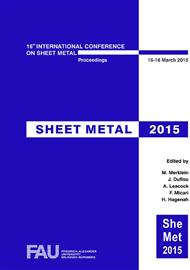p.485
p.493
p.501
p.509
p.517
p.525
p.535
p.543
p.551
Sheet Metal Laser Cutting Tool Path Generation: Dealing with Overlooked Problem Aspects
Abstract:
This paper deals with non-trivial problem aspects of laser cutting tool path generation that, to the best of our knowledge, received relatively little attention in the scientific literature. It is shown that some aspects such as plate edge nesting, skeleton and remnant cutting, and clamp positioning can be modeled and solved with little additional effort using existing tool path algorithms. However, concepts such as collision avoidance, pre-cut optimization, and bridge utilization prove to be more challenging and will require more profound algorithmic adjustments if these have to be taken into account fully. An even harder problem aspect is generating tool paths that are thermally feasible. Since laser cutting introduces net heat into the metal sheet, the metal sheet tends to heat up as the cutting progresses. Quality deterioration can occur if the laser spends too much time cutting in the same region. It is shown how to model the easy problem extensions in order to handle them using existing problem approaches and solution approaches are suggested to tackle the harder concepts. In addition, a proof of concept is presented that shows that thermal feasible tool paths can be generated through a multi-start heuristic utilizing a thermal penalty function. A finite difference method iteratively (or concurrently dependent on the used heuristic) evaluates the thermal feasibility and updates the penalty function.
Info:
Periodical:
Pages:
517-524
Citation:
Online since:
March 2015
Authors:
Keywords:
Price:
Сopyright:
© 2015 Trans Tech Publications Ltd. All Rights Reserved
Share:
Citation:


